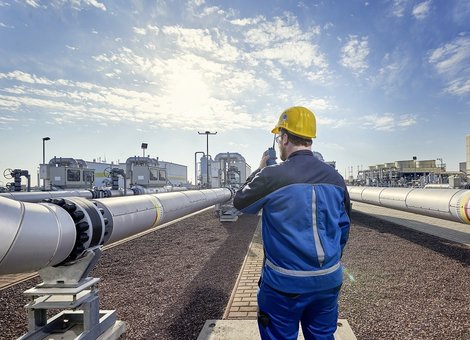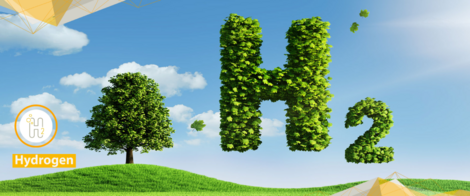The world’s first underground hydrogen storage facility is being created in Saxony-Anhalt
Green energy from the underground

Saxony-Anhalt puts the emphasis on green hydrogen in the energy transition. In the Bad Lauchstädt Energy Park, the world’s first large-scale trial of power-to-gas, the conversion of climate-neutral wind power into hydrogen, is being held, which involves transforming a salt cavern into a large storage facility. The project is now starting to take shape.
In Saxony-Anhalt, the energy transition is also happening underground
Around 700 to 900 meters below Goethestadt Bad Lauchstädt in southern Saxony-Anhalt, a cavern in the underground salt rock has been rinsed with brine. The cavern, which forms part of a combined system of caves and warehouse storage belonging to VNG Gasspeicher GmbH (VGS), has a capacity of around 50 million cubic meters. The huge Monument to the Battle of the Nations in Leipzig would fit into the cavern twice over. The cavern will be used for storing not natural gas, but green hydrogen. “The world’s first large storage facility for green hydrogen is being created here in the Bad Lauchstädt Energy Park. This is also the first attempt to produce hydrogen on this scale from wind energy, store it and process it further,” says Cornelia Müller-Pagel, head of the Green Gases department of the central German gas supply company VNG AG. The storage facility will hold up to 4,500 tons of climate-neutral hydrogen, which is enough to supply 64,000 2-person households with electricity for a year. “It would also enable a fuel cell truck to travel 1,100 times around the equator,” explains Müller-Pagel to give an idea of the quantity of hydrogen that the cavern can hold.
Hydrogen buses, climate-neutral solutions, wind power, storage – it’s all about the energy transition.
The underground hydrogen store is the central feature of the innovative Bad Lauchstädt Energy Park project. This joint project will consist of a large-scale electrolysis plant with a power output of up to 30 MW, where large quantities of water will be converted into oxygen and green hydrogen. In addition, a wind farm will be specially built to generate the climate-friendly electricity needed to manufacture the green hydrogen. A total of six players have come together in the unique Bad Lauchstädt Energy Park project to take part in a large-scale trial, which will evaluate the production, transport, storage and cost-effective use of green hydrogen on an industrial scale for the first time in real-life conditions. The hydrogen is primarily intended for use in the chemical parks in the region.
Bad Lauchstädt, a small town near Halle (Saale), meets the requirements for a large trial, which include an electrolysis plant with a direct connection to a large supply of volatile wind power and the infrastructure for storing and transporting the hydrogen. The features that make this location ideal include plenty of wind for generating electricity, the underground gas storage facility belonging to VGS and the existing infrastructure with gas pipelines and customers, such as the large chemical parks at Leuna and Schkopau, which are part of the nearby Middle German Chemical Triangle.
Living labs for the energy transition
The Bad Lauchstädt Energy Park was one of the ten innovation projects to win the “Living labs for the energy transition” ideas competition launched by the German Federal Ministry of Education and Research in 2019. Following this success and the subsequent prospect of funding, the scientific preparations and planning for the Bad Lauchstädt Energy Park project have now been completed. “The project partners are expecting the Federal Ministry of Education and Research to approve the funding in late summer. That’s when the second phase will begin, which will be divided into two stages. During the next five years, the wind farm, the electrolysis plant and the pipeline will be built and will come into operation. In addition, research will be carried out into important parts of the above-ground facilities. This will be followed by a second construction stage, when the underground storage and the remaining above-ground facilities will be built,” explains Cornelia Müller-Pagel from VNG AG. The total investment amounts to hundreds of millions of euros and the trial operation phase of the entire value chain is likely to last until 2030.
The VGS has already begun work on the implementation. The cavern in the underground gas storage area has been filled with brine. When the hydrogen is first fed into the cavern full of brine, it will push the brine out. Simply filling the cavern with gas for the first time will take around two years. Before this the underground storage facility has to be converted: “Hydrogen is more diffusible than natural gas. That’s not a problem in the case of the salt rock, which is not permeable. But all the pipelines and fittings both above and below ground will have to be prepared for use with hydrogen,” explains Cornelia Müller-Pagel. This includes a 20-kilometer-long connecting pipeline managed by ONTRAS Gastransport GmbH, a transport company that is a subsidiary of the VNG Group.
Creating a large-scale green hydrogen economy
The companies behind the Bad Lauchstädt Energy Park are the VNG subsidiaries VGS and ONTRAS, DBI - Gastechnologisches Institut gGmbH Freiberg, Terrawatt Planungsgesellschaft mbH and Uniper Hydrogen GmbH. The large-scale Bad Lauchstädt Energy Park power-to-gas project is also based on preliminary work carried out as part of several research projects under the umbrella of the HYPOS consortium, Hydrogen Power Storage & Solutions East Germany. This consortium, which was founded in 2013 and consists of businesses and research organizations, develops and promotes the creation of a large-scale green hydrogen economy, in particular in central Germany and in Saxony-Anhalt.
In addition, Saxony-Anhalt is a model region in this respect. Companies in the region, and in particular in the Middle German Chemical Triangle, have a long tradition of using hydrogen. A recent study by the German Economic Institute shows that there is no other region of Germany where the hydrogen infrastructure is already so advanced. The chemical sites in central Germany are connected by a 150-kilometer-long hydrogen pipeline. The Bad Lauchstädt Energy Park is one of the flagship projects in Saxony-Anhalt which will allow green hydrogen to be produced successfully on an industrial scale.
Author: Michael Falgowski/IMG Saxony-Anhalt

Saxony-Anhalt offers good starting conditions for the development of a forward-looking hydrogen economy.
As a traditional chemical site, the state has many years of experience with hydrogen utilization in the Central German Chemical Triangle.
